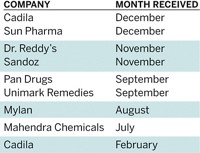Advertisement
Grab your lab coat. Let's get started
Welcome!
Welcome!
Create an account below to get 6 C&EN articles per month, receive newsletters and more - all free.
It seems this is your first time logging in online. Please enter the following information to continue.
As an ACS member you automatically get access to this site. All we need is few more details to create your reading experience.
Not you? Sign in with a different account.
Not you? Sign in with a different account.
ERROR 1
ERROR 1
ERROR 2
ERROR 2
ERROR 2
ERROR 2
ERROR 2
Password and Confirm password must match.
If you have an ACS member number, please enter it here so we can link this account to your membership. (optional)
ERROR 2
ACS values your privacy. By submitting your information, you are gaining access to C&EN and subscribing to our weekly newsletter. We use the information you provide to make your reading experience better, and we will never sell your data to third party members.
Safety
FDA Needs To Engage In Positive Re-enforcement
Drug safety can’t be a product of regulations alone
by Rick Mullin
June 1, 2015
| A version of this story appeared in
Volume 93, Issue 22

When Guy Villax, chief executive officer of the Portuguese pharmaceutical chemical firm Hovione, rose to speak at a company press conference in Paris last October, reporters in attendance were curious to hear what he’d have to say, their interest piqued by the title of his presentation: “Why Margaret Hamburg Needs Her Dean’s List.”
Presumably, everyone in the room knew that Hamburg was the head of the U.S. Food & Drug Administration. Few were aware of her dean’s list.
In fact Hamburg, who stepped down on April 1 after a six-year tenure, didn’t have one.
Villax continues to promote the dean’s list, an idea he first floated in a 2013 C&EN editorial. As Villax describes it, FDA should compile a list of companies that have demonstrated a “quality culture”—a spirit of operation that promotes processes and products above and beyond the compliance standards enforced by the agency. The agency then could inspect these companies less frequently.
Reporters at the Paris event may have been skeptical of the idea that “quality culture” is of equal importance to “law enforcement” in assuring drug safety. Some despaired of selling Villax’s dean’s list as a story idea to hard-bit editors back at the ranch, while others may have written the idea off as a marketing scheme. But Villax’s metaphor, rooted in a chemical industry tradition of proactive performance improvement, is in some ways in step with changes already under way at FDA to improve quality assurance.
Earlier this year, FDA established the Office of Pharmaceutical Quality within its drug safety division. OPQ’s remit is to streamline the regulatory process, develop product quality knowledge management and informatics, and bring parity to the oversight of generic and innovator drugs as well as domestic and international facilities.
While always a central concern, drug quality has become a burning issue at FDA given the recent run of drug recalls and a spate of contamination and counterfeit cases. By adding a nonenforcement element to FDA’s basic regulatory and inspection activities, agency officials hope to create a uniform drug quality program—“one quality voice”—spanning all manufacturing sites, domestic and foreign, and all drug types.
There is no mention of a dean’s list, a quality merit badge, or anything designed to identify high achievers as quality role models.
FDA will need to consider such a list, however, if it wants to add something like superquality to mere compliance. As Villax sees it, the agency needs to “use the carrot, and not the stick,” to reward companies that have internalized the essence of quality and continuous improvement. Compliance with regulations has nothing to do with quality, Villax contends. It merely maintains a lowest common denominator.
Another federal agency, the Occupational Safety & Health Administration, already maintains a dean’s list of sorts. OSHA’s Voluntary Protection Programs identify companies that have developed safety and health management regimes that result in injury and illness rates below national averages for their industries.
Speculating on why OSHA has pushed ahead with such a program, Villax notes that OSHA oversees a portfolio of private and government workplaces that dwarfs FDA’s plant inspection roster.
But FDA’s resources are also stretched, and the agency has indicated that it is open to the idea of an industry quality protocol that will fill in for inspections. For example, it has hailed best practices compiled by manufacturers of drug inactive ingredients. And the agency recently told C&EN it is exploring means of identifying firms with quality management systems that exceed regulatory requirements and may consider a reduced level of oversight for such firms.
Would the public tolerate a program in which drug and drug chemical makers police themselves? Villax’s ready answer—that the public “wants a capsule of quality, not a capsule of compliance”—may be a projection of his own views. Selling the dean’s list idea would be a challenge for FDA.
The agency should note that the chemical industry provides an excellent example of a sector improving itself without the regulatory stick. Unlike the U.S. nuclear industry, which was nearly brought to its knees when utilities circled the wagons after the accident at ThreeMile Island, the chemical industry has thrived since the deadly 1984 gas leak in Bhopal, India, thanks in no small part to a performance improvement program called Responsible Care.
Responsible Care succeeded in bringing about sizable improvements in health, safety, and product stewardship. As a result of Responsible Care, the industry claims, it has reduced process safety incidents by 50% and hazardous releases to the air, land, and water by 75% over the past two decades.
Communicating that success to the public has been a tougher job. The word “chemical” is still largely reviled.
But “quality” is revered in the chemical industry, largely because of the wave of change that followed the Bhopal disaster. “ ‘Five Past Midnight in Bhopal’ is required reading for management at Hovione,” Villax says, referring to the book by Dominique Lapierre and Javier Moro detailing the safety failures related to the methyl isocyanate gas leak in Bhopal that killed thousands.
Villax is serious about investing in quality. And Hamburg’s successor, whoever it will be, should recognize the industry’s quality culture as a huge resource as FDA struggles to secure the drug supply for the American public.
Views expressed on this page are those of the author and not necessarily those of ACS.





Join the conversation
Contact the reporter
Submit a Letter to the Editor for publication
Engage with us on Twitter